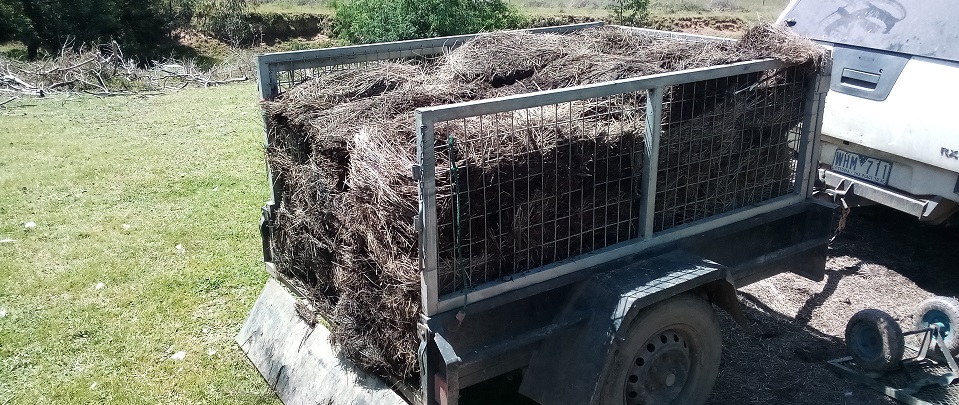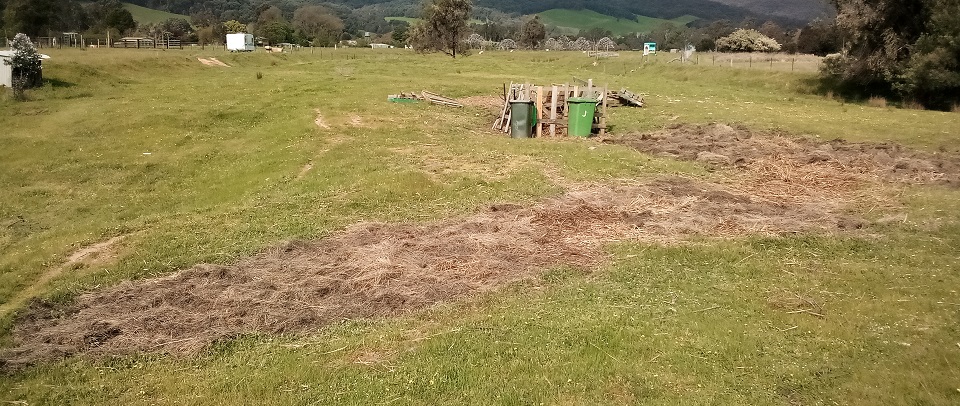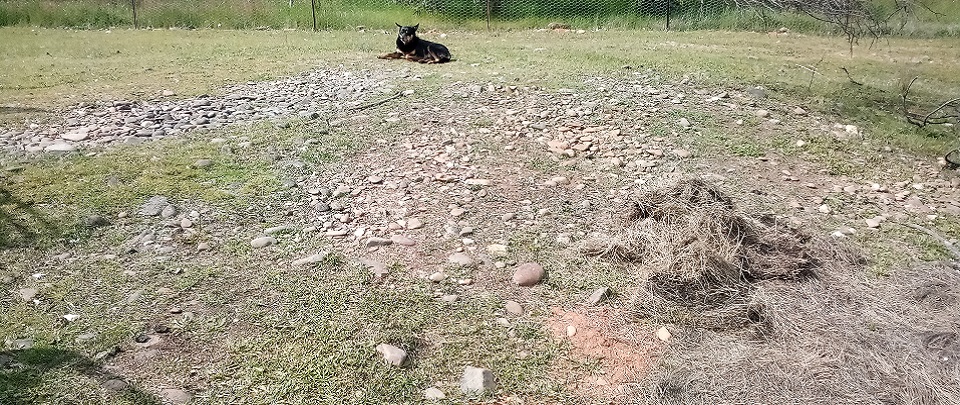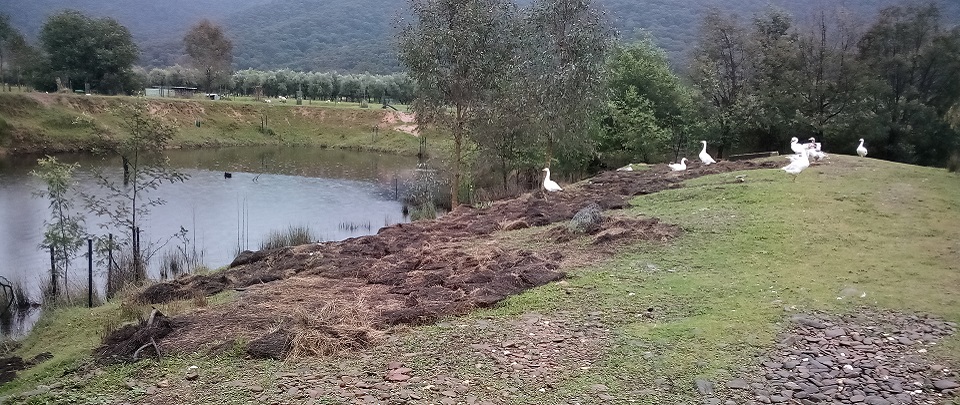More green fill
If you have followed this blog you will recall the misadventure of the free hay bales….too heavy, too far, car not up to the task etc. As it turns out, I worked out afterwards I bent the tailgate on the trailer when I was hauling the massive large bales off....the trailer rolled backwards and crushed the tailgate underneath, and I had to get it welded back into shape. So all up. not a big win.
In itself it wasn't a bad idea…get someone else's semi-decomposed hay and use it for mulching on a grand scale.
So I have been eying off the rotten hay across the road for a couple of months as a better prospect.
Our neighbours are a mix of small farms like ours, plus farming land that was split into suburban-sized blocks when that was still legal, and serious, professional farms. Next door is the massive hop farm that now runs all the way to Myrtleford. Two properties the other way is a commercial walnut farm. And across the road is a native grass seed farm.
Last year they cut and baled. That in itself was an indication something wasn't right. Normally they crop and shred out the seed. Baling it? What for? The baling was simply a way of clearing out the old crop to make room for the next one. They didn't want the bales, they had wanted the seed. They had no use for the bales, and they sat there. In the rain, for 8 months. No longer any use to them, and increasingly, a nuisance in the way of ongoing operations.
I went to their Facebook page to get their contact details. I was going to get in touch and see if they would let me take them away.
And it was a wow! moment. On Facebook they mentioned they occasionally sold their bales. The seed is a complex, labour-intensive product, and quite expensive. But you could buy a bale, use it as mulch, and get a few volunteer native grass seedlings sprouting from that. Someone had asked the question, how much the bales were. And the answer was….Normally we sell them, but this year they got wet and so we are giving them away.
And clearly that had not happened, as they were still there, and the post was quite old. A few days later I spoke to the manager who invited me over to check the site (and I suspect so he could suss out whether I was someone he wanted to deal with.)
There's more than 150 bales there. After we talked and I explained what I wanted them for, he said I can have them all. But I can only access them via designated laneways, no cutting across paddocks or grow areas. That scruffy spot is a test growth area, keep off. These areas over here are no go areas. Don't touch that pile of bales. Electric fences are on. I also need to tell them when I am onsite. All perfectly reasonable, the sort of briefing I would give someone at my place, we shook hands, I gave him a bottle of oil as a thank you, and we are off. And so close to home! Sounds great doesn't it?
Downside…the bales are wet, and rotten. And the continuous rain hasn't helped, both with soaking the bales and keeping the ground soft. They are no longer tight, and most are glued to the ground by mud and decomposition. They are so heavy! I get my hay cut in small bales because I can lift a small bale. But that's a dry bale. A sodden small bale weights at least double…maybe 50 kg. When you try and pick it up the bale breaks in half with the back end stuck to the ground, the baling twine slips off, the bale starts to fragment and you end up stacking it in the trailer a wedge at a time.
The laneways are very tight, and clogged with bales. Too tight for my big trailer. But even with my small trailer, there's not enough room to drive down the lane and access the bale without walking on the next crop. So I've ended up walking down the laneways and loading each bale onto a trolley and walking it back to the car/trailer. The trolley is a little garden trolley. If I lay it down sideways next to the bale, then flip the two of them together, the trolley ends upright with the bale on top. And the trolley is the same height as my trailer, so I can slide the bale in with it mostly not breaking. And the trolley means less lifting and carrying. All round a winner. But still...a trailer load means a walk of more than a kilometer. I can get nine bales in a trailer load. That’s maybe 450-500 kg. So far I've done 12 loads, which is up past 5000 kg of hay moved!

Small trailer loaded to the gunwales
The scale of it amazes me.
At this end there are lots of options.
In the ruined paddock I have one crater that you could have parked a bus in, two years ago. I have tipped 20 cubic metres of woodchip, trailers of dirt, olive prunings, green supermarket waste, trailers of horse manure, the odd sheep carcase, garden weeds and autumn leaves into it, and it is more than half filled. Its now had a dozen cubic metres of heavy, sodden bales piled into it. I can actually see that I might see this project finished!
In our main paddock is The Scar, a long gravel scrape where the topsoil was mined for roadbase. I've been putting loads on hay into that, and its now very close to being rehabilitated.

The photo doesn't convey how damaged this was, now that its nearly repaired! it's always been cropped out of photos as it was so ugly. The hole was more than 40 metres long, two metres wide and 30-50cm deep, and there were piles of rubble all around it. Rubble gone or levelled out, cavities filled....nearly there.
In the goose paddock the rise from the mining pit/quarry/waterhole is mining spoil…a cascade of river stone was dumped there more than 100 years ago. A century later, it's now covered by 2 mm of soil, and in summer fries in the heat. Well, it used to. In the last twelve months at the top of the pile I have built s sort of a bund out of olive tree prunings, and focused on rehabilitating the inner circle. In the ring itself are trees. They have a low strike rate given how bad the ground is, but the prunings provide a bit of shade and water retention, and there are now slowly emerging saplings. Maybe not in my lifetime that will be a shady grove. By the water the edges have been raised along the contours using logs and backfilled with soil, manure and now slices of rotten hay bales. I've planted lots in the new "soil". At the moment it looks messy, but I am confident we will see something good happening over the next 12-18 months.


And I am using a few bales to pad out some potholes that annoy me. I've been doing that since we arrived. The place is covered in pits and lumps. In general terms it doesn't matter, its mostly sheep grazing territory and they don't care, but some of the potholes are in a line I drive through and the thump as we bottom out annoys me. The hay bales make a great filler, and you can split the sheaves to calibrate the pothole fill.
This has been going on for more than a month, and by my calculation I am only half done. While that's been happening the day-to-day work on the seed farm has continued, and with the wet they have had another paddock spoil. There's a lot more to take away, if I can keep up.
